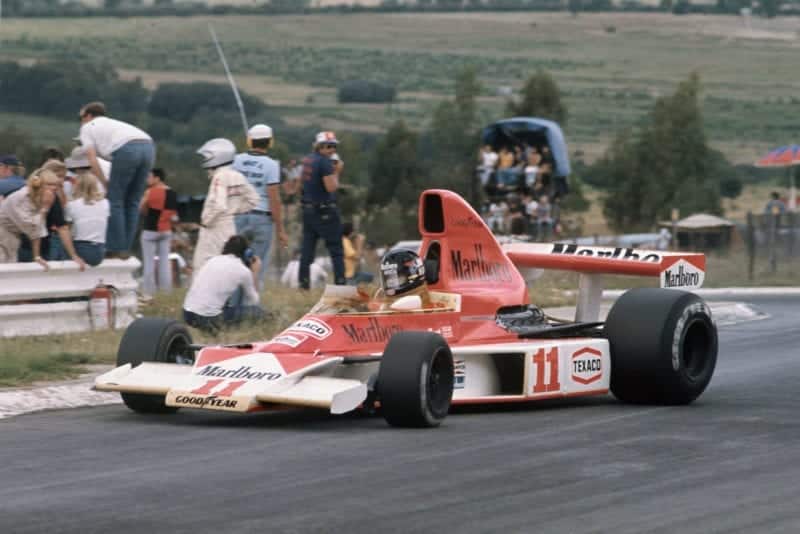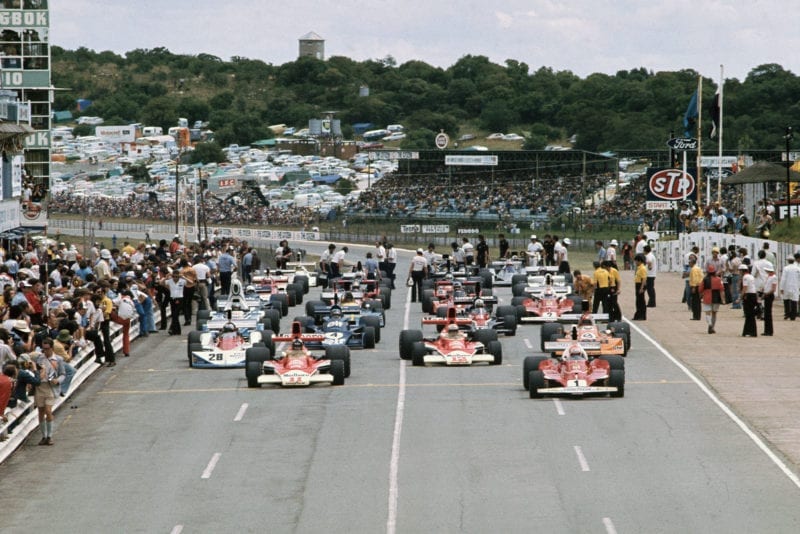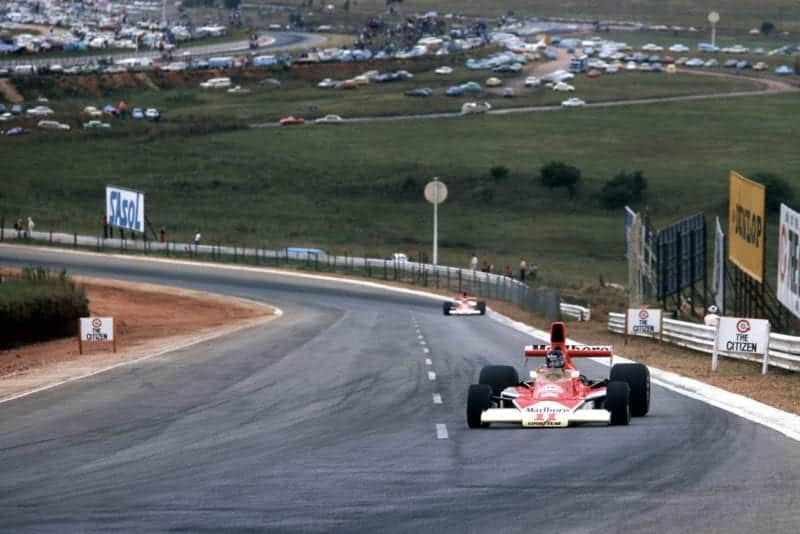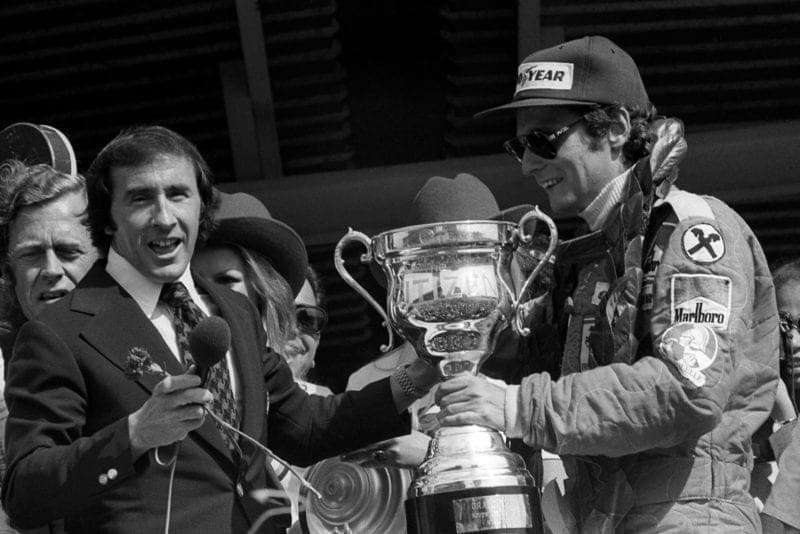1976 South African Grand Prix race report

Niki Lauda won his second race in a row for Ferrari
Motorsport Images
A retrospective view Kyalami, March 6th
Although Niki Lauda won the South African Grand Prix in apparently comfortable style, this is in no way a reflection of the efforts of several other teams who rely on Cosworth’s long-lived DFV 3-litre V8 for their motive power. At some points during 1975 one could almost sense that one or two teams had virtually given up the difficult task of trying to beat the Italian cars, there being a feeling “oh well, the best we can do is to race for second place since they’ve got 40 brake horsepower more than us”. The fact of the matter is that while Lauda was pretty good, winning five out of the fourteen World Championship qualifying rounds, he wasn’t totally dominant and it was possible to beat him, or give him a run for his money in certain circumstances. James Hunt proved that it could be done with his splendid Zandvoort victory, Patrick Depailler gave the Austrian an enormous fright at Nurburgring (where Reutemann won) and Emerson Fittipaldi proved that a Ferrari could be caught and passed at Monza where his McLaren M23 finished second, sandwiched between the two Italian cars.
This year Lauda has got off to a fine start, winning at both Interlagos and Kyalami, both circuits on which he was not expected to do well. In fact, it should be remembered that the 312 transversale had its first race on the Brazilian track in 1975 as the team was still relying on their 1974 312B3 models for last year’s race and as the 1975 South African Grand Prix marked the debut of the new Ferrari, so one didn’t in truth know what to expect from Lauda and his machine. Since then the young Austrian has improved immeasurably, confidence and assurance steadily increasing hand in hand with his experience and the way in which he took the first two races in his stride was what one should expect from a worthy World Champion. However the signs of opposition are once again evident. In neither ,Brazil nor South Africa did Lauda Start the race from pole position. On both occasions he did start from the front row, but he was beaten in the official practice sessions at both races by James Hunt, the former Hesketh driver who replaced Emerson Fittipaldi as team leader at McLaren Racing. At the time of his abrupt departure from McLarens, Fittipaldi left the Colnbrook team in a bit of a quandary for it was by no means clear just who was the most suitable candidate to fill his vacant seat. The McLaren directors thought very carefully for a long time before nominating Hunt and the wisdom of their choice was proved in South Africa where he raced tremendously hard for the entire race, gobbling up the Ferrari’s advantage in the closing stages as Lauda slowed with a deflating rear tyre.
In fact the McLaren team were looking very pleased with themselves after the Kyalami race for not only had Hunt finished second, but Jochen Mass was third, on the same lap, in the other M23. It was a long, hard race and McLarens could feel justifiably content in being the only team having two healthy cars finishing so high up in the results. The only way they could have improved on that would have been by finishing first and second, but otherwise they had the satisfaction of seeing a job well done.
All through the winter the team’s diligent designer Gordon Coppuck has been hard at work pencilling the design of the new M26 Grand Prix chassis but his design team has still found time to effect plenty of improvements, to the existing M23s. Every avenue to increase performance and reduce unnecessary weight has been explored and the result of these efforts has been to shed “at least thirty pounds”. Lightweight body panels, suspension alterations and the adoption of a compressed air starter motor have all Contributed to this improvement and much of this work has been completed under the direction of team manager Alistair Caldwell, leaving Coppuck free to work on the new chassis.

James Hunt claimed pole for McLaren
Motorsport Images
The compressed air starter motor is a novel idea and our attention was attracted to it when we sow one of the McLaren mechanics apparently plugging a compressed air line onto the rear end of Hunt’s car. Casting aside our initial suspicions that they were perhaps blowing up their driver, further examination revealed that the air line was feeding an air bottle-cum-starter motor, the arrangement simply using the force of the compressed air to rotate the Bendix in place of an electrical charge. The effect of this is to enable the car to carry a much smaller battery as much less charge is required to activate the starter motor and the reason the air line was attached to the back of the car during the pit stop was to keep the system as fully primed as possible just in ease it was required “in anger” out on the circuit away from the mechanics. Just as other teams use “booster” batteries to start their cars from the pits, the McLaren team employed the air line in similar fashion.
The argument and discussion involving the aerodynamic plastic “skirts” round the lower side of the McLaren chassis might well have centred round an apparent ambiguity between two successive paragraphs in the FIA rules and regulations, but in reality, proved a rather petty diversion during a busy weekend. The objection was raised by rival teams after the Official practice sessions were over and hinged round the section of the FIA book of words which states that “no element of the coachwork shall exceed in height an horizontal plane situated at 80 cm. above the lowest point of the entirely sprung structure of the car, with the exception of the safety roll bars and of the elements strictly related to the functioning of the engine (air boxes). In other words, a car with its wheels and the mobile suspension elements removed, but without regard to the roll-over bar, must pass between two parallel planes separated by 80 cm. . .” The objection to the skirts on the McLaren was simply that they lowered the bottom of the “structure” to the point where it would not pass between two hypothetical parallel planes. The argument seemed petty, the advantage gained by these skirts problematic and the McLaren team resolved the whole silly affair by taking the skirts off both their cars. They still finished second and third in the race, so obviously they were not unduly troubled by this post-practice pantomime.
Amongst the originators of this protest was Ken Tyrrell and the Ripley constructor was again in the “pit lane headlines” during another row which brewed up after Brambilla’s March had refuelled during the closing stages of the race, still finishing in front of Depailler’s car. Tyrrell challenged March’s Max Mosley with the accusation that “the use of NASCAR cans” is forbidden for refuelling according to the “pink pages” in the FIA tome. But Mosley’s legal dexterity quickly came up with an answer for this one and he replied “Oh no Ken, our can isn’t a NASCAR can. Ours is a common or garden can. If the FIA had wanted to ban common or garden cans they would have said so…”
Tyrrell was apparently so angry that he wrote out a protest, handed it to Jody Scheckter and rushed off to the airport in a helicopter. Only when he got back to England did he realise that he hadn’t, in fact, enclosed the protest to the Clerk of the Course. Back at Kyalami, Clerk of the Course Francis Tucker was left wondering why Scheckter had presented him with a sealed envelope from his entrant which turned out to contain a grid sheet along with the protest fee!
There is a moral to this tale which must be only too obvious and can be seen when one compares where some cars finished as opposed to others. Perhaps a little less effort might be expended indulging in this sort of unnecessary amateur polities and a little more towards trying to beat (or even get on terms with) the McLarens and Ferraris which now feature regularly towards the front of the current Formula One starting grids.
Colin Chapman’s Lotus team were too busy and too determined on sorting out their own problems without wasting time shouting the odds, and one might have expected them to he downhearted and depressed about their apparent plight with two new drivers and two troublesome racing cars. The fact of the matter is that they exuded a great deal of hope for the future, drivers Nilsson and Evans approaching their task with great gusto, trying for all they, were worth. After a year or so of deteriorating relations with their drivers it must have come as a welcome change to encounter such willingness rather than having somebody sitting on the pit wall, long-faced and miserable, criticising every half hour or so. At the finish of the race, Evans was welcomed with open arms after finishing tenth on his first outing in a Lotus. A small step perhaps, but progress indeed since Brazil where two much more experienced “aces” contrived to collide with each other!
Race

The race begins in South Africa
Motorsport Images
The race itself at Kyalami proved fascinating for the enthusiastic and informed onlooker, if a trifle dull and processional for the casual spectators. Once Lauda’s Ferrari had taken its early commanding lead, the field split up into several groups with Vittorio Brambilla’s March 761 doing its best to thwart the progress of the two McLarens during the opening stages. After the race was over there was a great deal of stern talk about the way in which Brambilla had “dangerously” baulked some of his rivals and “closed the door” in pretty rough style against some of his more exalted colleagues. The swarthy little man from Monza knows only one way to go motor racing and that is hard, so the McLaren drivers simply had to fight their way past him as indeed they did in fine style, Hunt might well have had a better chance of catching Lauda if he hadn’t beer, held up by the Italian, but he would have had an even better opportunity of catching the Ferrari if he had made a better start from his position on the outside of the front row. As it was, Lauda didn’t have any difficulty passing anyone because he Made the best start and that was that.
Once the McLarens had disposed of Brambilla the next task was for Ronnie Peterson, Patrick Depailler and the Brabham-Alfa Romeo of Reutemann to get on terms with the orange March. Depailler found this all a little too hectic, badly misjudging his braking at the end of ‘the long start/ finish straight and spinning in the middle of the corner. Peterson was the unlucky one who could not avoid the gyrating Tyrrell and the heady Frenchman almost precipitated another accident by driving straight out into the middle of Crowthorne Corner just as Chris Amon came into the “firing line” with the Ensign. Both the Brabham-Alfas spent the early laps of the race spraying oil all over their pursuers, and by the time both Pace and Reutemann took their leave of the proceedings and made for the pit lane with no lubricant left, the cars driven by Andretti, Laffite and Watson were smeared with thick oil streaks from nose cone to airbox.

Hunt eventually finished 2nd
Motorsport Images
By lap 25, quarter distance, the race had really lost all semblance of entertainment value. Lauda and Hunt were lapping steadily in the first two places with a large advantage over Mass in third position. Then came Pryce’s Shadow DN5, Regazzoni’s Ferrari, Brambilla’s March which was now finding the pace a little bit too much, Jody Scheckter’s Tyrrell and the Ligier-Matra. Fortune didn’t seem to be smiling much on the 12-cylinder cars in the race for, apart from the two Brabham-Alfa Romeo failures, the Ligier eventually blew up while racing closely with Brambilla’s March and Regazzoni’s Ferrari also succumbed to mechanical failure. The Swiss driver was having a very lack lustre weekend, never remotely approaching his team-mate’s competitive lap times. And they still say that Lauda only wins because he has the better car . . .
During the race’s closing stages there was not a great deal to enliven the proceedings until it became clear that Lauda was in slight difficulties with a slowly deflating left rear tyre. The pressure loss took place very gradually over the last few laps of the 78 lap race, but it was enough to prompt the World Champion to ease his pace slightly which allowed Hunt to close the gap between them dramatically. Pacing himself as easily as he dared, Lauda still had 1.3 secs. in hand over the gallant English driver at the finish which was further on the road than it looked on paper. Behind Mass, Jody Scheckter was the only other driver to complete the full 78 lap distance ahead of Watson and Andretti.

Lauda celebrates his second win of 1976
Motorsport Images
Pryce, Brambilla and Depailler had all been delayed in one way or another, the first-mentioned for a deflated tyre to be replaced, and Evans beat Brett Lunger’s new Surtees TS19 into 11th place with the Lotus. Behind Stuck’s 12th place March 761 came new Williams recruit Michel Leclere, the young French Formula Two driver having his first race in the “all new” Williams FW05/2 as opposed to the “Hesketh-Williams” driven by Ickx. Leclere’s car had been involved in a first corner collision with Ian Scheckter’s privately owned Tyrrell but still finished ahead of Chris Amon in the Ensign. Amon worked Nunn’s old Ensign MNO2 up to eighth place at one stage before stopping for more fuel, more than adequate proof that a bit of enthusiasm behind the wheel can more than make up for all the chassis technical improvements that money can buy. Talking about money, the Copersucar Fittipaldi broke its engine in the race while running well down the field after the most troubled official practice imaginable. What was that about everyone can build a successful Grand Prix car?—A.H.
